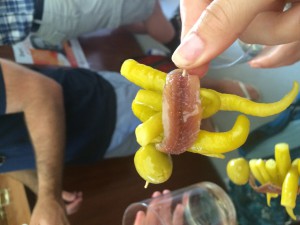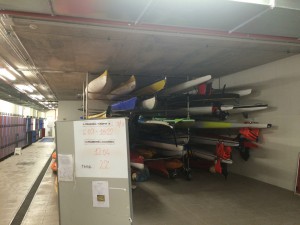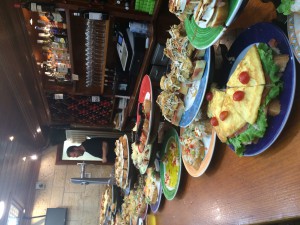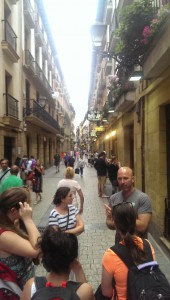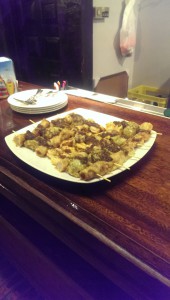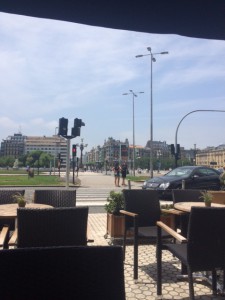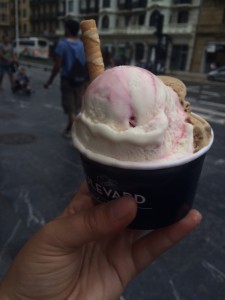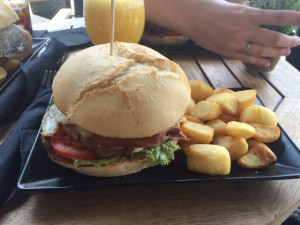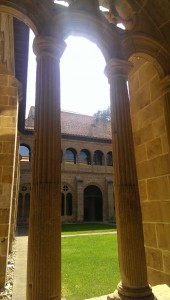When I first purchased my plane ticket to Spain, I was aware that I would be voluntarily immersing myself in a completely new culture. I brought with me five shirts, five shorts, four bathing suits, and one open mind.
Today, my open mind was put to the ultimate test during a “Basque Cooking Class”. My expectation was that the class would go to a kitchen to prepare a meal alongside the chef. To my surprise, this was not true at all. In fact, due to Basque tradition, women were not even allowed to cross the line into the kitchen. They merely came to eat. They were not even allowed to wash dishes. This was shocking to our group of young Americans, some of which were extreme feminists.
In order to get a sneak peak into the kitchen, I gave my camera to Eric Miller, who served as my eyes on the other side of the line. Behind the counter, the chef began to make Marmitako, which is a sort of fish stew. It is thick and chunky with large pieces of potato and tuna. None of the men from class actually cooked. Instead they just observed, so I suppose I did not miss too much in the kitchen.
What I found interesting was the honesty policy that has been implemented in the Basque country. When you go to a bar for pintxos or if you’re a member at a bar, you take your pintxos and you drink your drinks first. Afterwards, you tell the bartender what items you had already enjoyed in order to pay. To show how much you have had to drink, you are expected to keep the lids and pay for them that way. There is a lot more trust between the consumers and the owners here than there is in the United States, and I really admire that part of the culture.
At first when we all sat down, we made a very traditional pintxo. We were given small sword-like toothpicks as well as olives, onion balls, anchovies, and peppers. The word pintxo means to pierce, and that is exactly what we did. First, we slid the pepper onto the spear followed by the anchovy, the olive, and the onion ball. The tail ends of both the pepper and anchovy were wrapped around the olive and the onion and pierced again.
The flavor was very strong. The vinegar was prominent and the peppers were delicious. We could not get too full, though, because this was just the beginning.
Next, we enjoyed a salad and copious amounts of delicious bread. We were given multiple bottles of cider which was much harder to pour than one would think. The idea is to pour the glass from far away, but only real artists seemed to have that skill mastered. As we finished the course, the chef brought out the stew. The students on my end of the table managed to finish two entire pots alone. The students described the taste as fresh, perfect, and “so good”.
For dessert we enjoyed a Patxineta. Apparently this pastry is a Basque version of a French dessert. It is a warm creme surrounded by sugary crust. It was simple and delicious.
Overall, I had a great time during the class. This cooking class exhibited many common traditions of Basque culture, and I would recommend it to all who travel, especially to the women who would like a break from the kitchen.


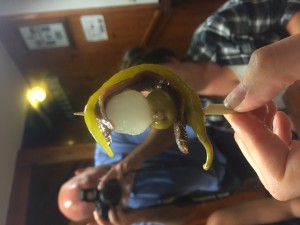
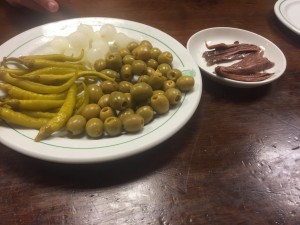
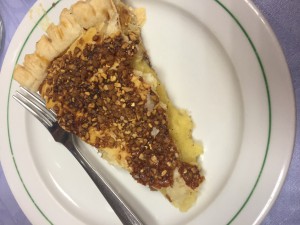

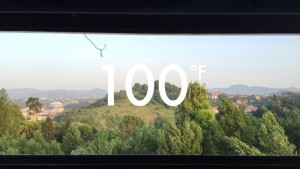
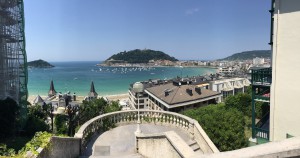 During our 30 minute lunch break,my friends and I tried a bakery near the school. Needless to say, the pastries were delicious.The rest of the daily routine consisted of hunting for lunch, taking a siesta, and prepping for the long awaited mini cruise. Leighton and I took the scenic route, a white staircase that overlooked La Konxta beach and The Bay of Biscay.
During our 30 minute lunch break,my friends and I tried a bakery near the school. Needless to say, the pastries were delicious.The rest of the daily routine consisted of hunting for lunch, taking a siesta, and prepping for the long awaited mini cruise. Leighton and I took the scenic route, a white staircase that overlooked La Konxta beach and The Bay of Biscay.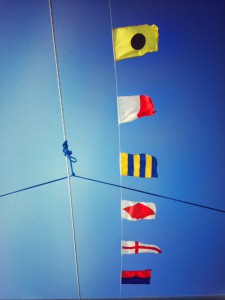
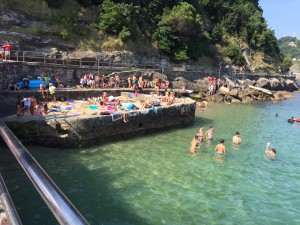 Once we docked at Santa Clara Island, we were again greeted by the cheery and festive spirit of this city. The island was packed with people swimming, playing on the beach, and enjoying the ISLAND BAR. This place really is incredible, but we did not stop for refreshments. Our destination was the top.
Once we docked at Santa Clara Island, we were again greeted by the cheery and festive spirit of this city. The island was packed with people swimming, playing on the beach, and enjoying the ISLAND BAR. This place really is incredible, but we did not stop for refreshments. Our destination was the top.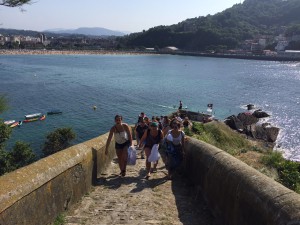 climbed this mini mountain, I could faintly hear Miley Cyrus’s “The Climb” echoing through my head It ain’t about how fast we got there, and it ain’t about what was waiting on the other side (although the scenery was gorgeous), it’s about the climb and the journey we all took to get there together. The 20 strangers that started this trip had now become great friends and traveling companions.
climbed this mini mountain, I could faintly hear Miley Cyrus’s “The Climb” echoing through my head It ain’t about how fast we got there, and it ain’t about what was waiting on the other side (although the scenery was gorgeous), it’s about the climb and the journey we all took to get there together. The 20 strangers that started this trip had now become great friends and traveling companions.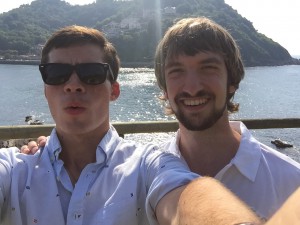


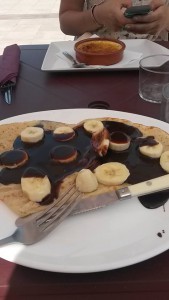
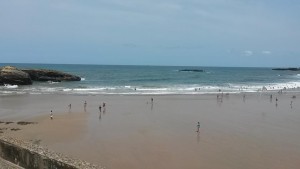
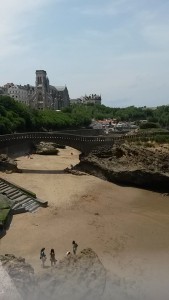
 where they bottled the wine for the year and where each step of creating the wine takes place. The man explained that the entire process, before fermentation, of collecting the grapes and creating what is going to be the wine within fifteen to twenty days. This happens in either in September or October depending on the weather and the ripeness of the grapes.
where they bottled the wine for the year and where each step of creating the wine takes place. The man explained that the entire process, before fermentation, of collecting the grapes and creating what is going to be the wine within fifteen to twenty days. This happens in either in September or October depending on the weather and the ripeness of the grapes. be their own nation. There was a sign hanging above where the group was preforming that read, “Tourist remember: this is neither Spain, nor France. You are in the Basque Country.” These people are fighting for their independence on a day that our nation celebrates our own. It was amazing to see a demonstration that gave insight to Basque culture and history, and it was a perfect way to end our day trip. Today was a day that will be ingrained into our memories for the rest of our lives.
be their own nation. There was a sign hanging above where the group was preforming that read, “Tourist remember: this is neither Spain, nor France. You are in the Basque Country.” These people are fighting for their independence on a day that our nation celebrates our own. It was amazing to see a demonstration that gave insight to Basque culture and history, and it was a perfect way to end our day trip. Today was a day that will be ingrained into our memories for the rest of our lives.